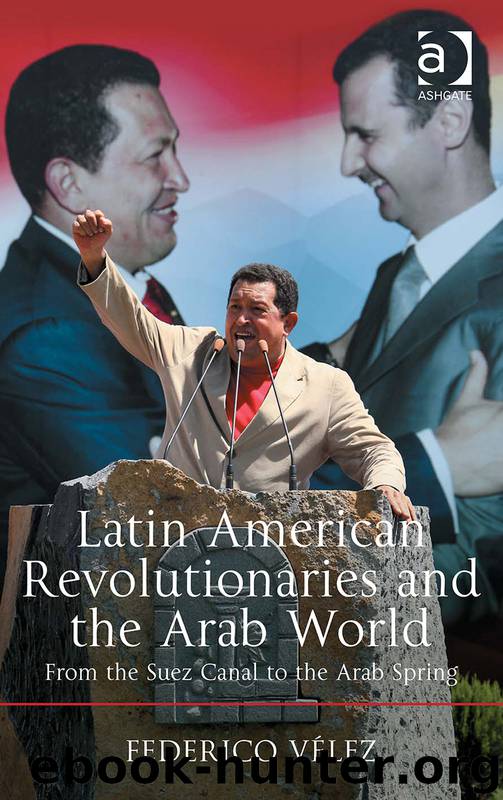Latin American Revolutionaries and the Arab World by Vélez Federico

Author:Vélez, Federico
Language: eng
Format: epub
Publisher: Taylor & Francis (CAM)
Published: 2015-03-14T16:00:00+00:00
The Frente Sandinista de Liberación Nacional (FSLN): 1961 to 1967
Fidel Castro’s decision to align Cuba closer to the Soviet Union had profound effects on small revolutionary groups in the Americas. This was particularly evident in Nicaragua. The history of Nicaragua’s Sandinistas was one of incessant defeat until its final victory over the dictatorship of Anastasio Somoza Debayle on July 19 1979.
Carlos Fonseca Amador, the founder of the Frente Sandinista de Liberación Nacional (FSLN), was a committed member of Nicaragua’s Socialist Party (PSN). The PSN commissioned him to attend the Sixth World Congress of Students and Youth for Peace and Friendship in Moscow in 1957. Fonseca admired the material and social progress achieved by the Soviet Union and Eastern Germany, and he supported the Soviet stance on international affairs, particularly Moscow’s path to peaceful coexistence with the West. For Fonseca, there was no question of deviation from Moscow’s leadership. The Cuban revolution in 1959 shocked Fonseca and the members of his generation who aspired to social change. The Cuban revolutionaries proved that a nationalist movement could succeed without the guidance and control of what many had begun to perceive as fossilized communist parties.22
Revolutionaries outside Cuba had been welcomed in Havana since 1959. Fonseca joined the “Rigoberto López Pérez” brigade, a guerrilla group manned and trained by the new Cuban government. On the continent, the Honduran armed forces and the Nicaraguan National Guard swiftly surprised and defeated the guerrillas at El Chaparral near the Nicaraguan border. To the PSN, this came as confirmation that armed struggle was not feasible in Nicaragua and that the only way to achieve victory was by following Moscow’s prescription for change through the electoral system. Fonseca, who miraculously escaped the El Chaparral defeat after being wounded and incarcerated, ended up in Havana. Defeat reinforced his commitment to form a broader movement of national liberation that was independent of the Socialist Party. With inspiration from Augusto Cesar Sandino, a nationalist leader who led a successful guerrilla resistance movement to the US Marines’ occupation of his country from 1927 to 1933, Fonseca organized a guerrilla group. Sandino had also fought against a political and economic system controlled by a handful of families. Fonseca’s movement followed the Cuban guerrilla model. His militia was organized in the jungle and in the countryside; over time the movement gathered enough strength to descend on Nicaragua’s cities in a nationwide insurrection against the dictatorship of the Somoza family, in power since 1936.
The FSLN, a new Cuban-oriented guerrilla group, moved to Rios Coco y Bocay in northern Nicaragua. Throughout 1962, the FSLN sent combatants through Honduras. In 1963 a poorly armed force of 63 men with scant knowledge of the terrain and no contacts with the non-Spanish-speaking local population braced themselves for a serious defeat. They were unprepared for hunger and illness, the jungle, and Somoza’s feared National Guard.
Download
This site does not store any files on its server. We only index and link to content provided by other sites. Please contact the content providers to delete copyright contents if any and email us, we'll remove relevant links or contents immediately.
| Africa | Americas |
| Arctic & Antarctica | Asia |
| Australia & Oceania | Europe |
| Middle East | Russia |
| United States | World |
| Ancient Civilizations | Military |
| Historical Study & Educational Resources |
Cecilia; Or, Memoirs of an Heiress — Volume 1 by Fanny Burney(32068)
Cecilia; Or, Memoirs of an Heiress — Volume 3 by Fanny Burney(31463)
Cecilia; Or, Memoirs of an Heiress — Volume 2 by Fanny Burney(31413)
The Secret History by Donna Tartt(18190)
Sapiens: A Brief History of Humankind by Yuval Noah Harari(13994)
Leonardo da Vinci by Walter Isaacson(12810)
The Radium Girls by Kate Moore(11627)
Sapiens by Yuval Noah Harari(5125)
How Democracies Die by Steven Levitsky & Daniel Ziblatt(4966)
The Wind in My Hair by Masih Alinejad(4850)
Homo Deus: A Brief History of Tomorrow by Yuval Noah Harari(4692)
Endurance: Shackleton's Incredible Voyage by Alfred Lansing(4513)
Man's Search for Meaning by Viktor Frankl(4295)
The Silk Roads by Peter Frankopan(4275)
Millionaire: The Philanderer, Gambler, and Duelist Who Invented Modern Finance by Janet Gleeson(4108)
The Rape of Nanking by Iris Chang(4024)
Hitler in Los Angeles by Steven J. Ross(3803)
The Motorcycle Diaries by Ernesto Che Guevara(3790)
Joan of Arc by Mary Gordon(3790)
